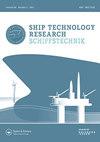An alternative Vorticity based Adaptive Mesh Refinement (V-AMR) technique for tip vortex cavitation modelling of propellers using CFD methods
IF 0.9
Q3 ENGINEERING, MARINE
引用次数: 12
Abstract
ABSTRACT This study focuses on the investigation of cavitating flow around the benchmark INSEAN E779A model propeller with the main aim of further improving the computational efficiency of the tip vortex cavitation (TVC) modelling by using a commercial CFD solver. Also, the effects of various key computational parameters including, numerical modelling, grid size, timestep, water quality and boundary layer resolution, on the TVC formation and its extension in the propeller slipstream are investigated systematically. The numerical simulations are conducted in uniform and open water conditions using RANS, DES and LES solvers implemented in the commercial CFD code, Start CCM+. In order to achieve the aim of the study, an alternative and new Vorticity-based Adaptive Mesh Refinement (V-AMR) technique is introduced for enhanced modelling of the TVC on the blades and downstream. For the CFD modelling of cavitation, the Schneer Sauer cavitation model based on the reduced Rayleigh Plesset equation is used for the sheet, tip and hub vortex cavitation. The hydrodynamic results and cavity patterns are validated with the experimental data. The results show that the application of the V-AMR technique further improves the representation of the TVC with minimal increase in computational cost. However, the eddy viscosity at the propeller blade tips increases with applying the V-AMR technique using the RANS solver due to its inherent modelling errors for the solution of the flow inside the tip vortex. This consequently results in an insufficient extension of TVC in the propeller slipstream compared to the predictions by the DES and LES based numerical solvers. Also, the evolution of the TVC is found to be sensitive to the boundary layer resolution when the standard RANS solver is used. The study will help to widen further applications of the CFD methods involving TVC, particularly for propeller induced underwater noise prediction and analysis.基于涡度的自适应网格细化(V-AMR)技术在螺旋桨叶顶涡空化CFD建模中的应用
摘要本研究的重点是研究基准INSEAN E779A模型螺旋桨周围的空化流动,主要目的是通过使用商业CFD求解器进一步提高叶尖涡流空化(TVC)建模的计算效率。此外,还系统地研究了各种关键计算参数,包括数值建模、网格大小、时间步长、水质和边界层分辨率,对TVC的形成及其在螺旋桨滑流中的扩展的影响。数值模拟是在均匀和开放水域条件下进行的,使用商业CFD代码Start CCM+中实现的RANS、DES和LES求解器。为了实现研究目的,引入了一种新的基于涡度的自适应网格细化(V-AMR)技术,用于增强叶片和下游TVC的建模。对于空化的CFD建模,基于简化瑞利-普莱塞特方程的Schneer-Sauer空化模型用于叶片、叶尖和轮毂涡流空化。实验数据验证了流体动力学结果和空腔模式。结果表明,V-AMR技术的应用在计算成本增加最小的情况下进一步改进了TVC的表示。然而,使用RANS求解器应用V-AMR技术时,螺旋桨叶尖处的涡流粘度会增加,这是因为其在叶尖涡流内部流动求解时存在固有的建模误差。因此,与基于DES和LES的数值求解器的预测相比,这导致螺旋桨滑流中TVC的扩展不足。此外,当使用标准RANS求解器时,发现TVC的演变对边界层分辨率敏感。该研究将有助于拓宽TVC CFD方法的进一步应用,特别是在螺旋桨诱导水下噪声预测和分析方面。
本文章由计算机程序翻译,如有差异,请以英文原文为准。
求助全文
约1分钟内获得全文
求助全文

 求助内容:
求助内容: 应助结果提醒方式:
应助结果提醒方式:


